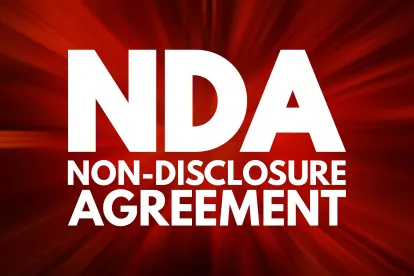A recent decision by the Ninth Circuit Court of Appeals in BladeRoom Group Limited v. Emerson Electric Co. further stresses the importance of carefully crafting the terms and conditions in a non-disclosure agreement (“NDA”), and ensuring there is no ambiguity as to when the NDA’s confidentiality protections expire. The Court in Bladeroom reversed a multi-million dollar judgment for the plaintiff, based largely on the Court’s differing interpretation of the duration of the confidentiality obligations under the NDA.
The Inclusion of Expiration Dates in NDAs
Under both the Uniform Trade Secrets Act (adopted by every state but New York) and the federal Defend Trade Secrets Act, the owner of a trade secret must make reasonable efforts to maintain the secrecy of the information the owner wishes to protect. Whether a party took reasonable steps to protect the trade secret is a factual question for the jury to decide. One of the most common “reasonable steps” is the use of an NDA that expressly sets forth the parameters for protection. NDAs are especially essential when sharing information with another business, such as during a joint venture or potential merger.
When drafting an NDA, the owner of the protected information must determine whether to include an expiration date for the agreement. Because the expiration of certain obligations under the NDA could place a company’s trade secrets at risk, indefinite protection obviously is preferred. In fact, at least two district courts have held that allowing an NDA to expire demonstrates that the trade secret owner failed to take reasonable measures to preserve the secrecy of the information.[i] On the other hand, the inclusion of an expiration date also limits the scope of any potential restraint on trade, thereby providing some protection against a finding that an NDA is void because it is excessive or broader than necessary to protect the owner’s interest, especially with regard to NDAs signed by employees. Thus, the guidance on whether to include an expiration date in a particular NDA can vary. The recent decision in Bladeroom demonstrates what can happen when the drafter of an NDA tries to have it both ways.
Ninth Circuit’s Decision in Bladeroom
In August 2011, the plaintiff, an English data center design company, drafted an NDA in connection with negotiations over its potential sale to a competitor. The acquisition fell through and the following year, the plaintiff and competitor subsequently bid on the same data center construction project. However, the plaintiff was unaware of the competitor’s bid until the competitor entered into a design-build contract with the customer, which occurred two and a half years after the competing companies signed the NDA. The plaintiff then sued the competitor and the customer in the U.S. District Court for the Northern District of California, claiming that the competitor’s design for the data center copied the plaintiff’s technology and asserting breach of contract, trade secret misappropriation, and other claims.
The second paragraph of the NDA, which was governed by English law, contained a dozen subparagraphs detailing the competitor’s confidentiality obligations. Among the subparagraphs, one barred the competitor from disclosing information that the plaintiff shared with the competitor “at any time” and another subparagraph stated that any disclosed information “shall remain the property of” the plaintiff and “shall not confer” “any rights or license whatsoever” to the competitor. The third paragraph of the NDA further stated that its confidentiality obligations did not apply to information that was in “or hereafter comes into[] the public domain, otherwise than by reason of breach of” the NDA. In addition, the twelfth paragraph of the NDA stated as follows:
The parties acknowledge and agree that their respective obligations under this agreement shall be continuing and, in particular, they shall survive the termination of any discussions or negotiations between [competitor] and [plaintiff] regarding the Transaction, provided that this agreement shall terminate on the date 2 years from the date hereof.
Prior to trial, the plaintiff moved in limine to prohibit the competitor from arguing that, as a matter of law, the proviso in the NDA’s twelfth paragraph allowed the competitor to use the plaintiff’s confidential information two years after signing the NDA. The district court granted the motion on the grounds that the NDA’s confidentiality obligations did not expire under paragraph twelve and survived beyond two years for the following reasons: (1) the “purpose” of the NDA was to protect information, not to provide for its release after two years: (2) “a reasonable businessperson in either party’s position would not have contemplated the competitor’s [reading];” and (3) the competitor’s reading “would lead to an absurd result and would create some inconsistency with the rest of the [NDA].” The trial court entered judgment on the jury verdict awarding plaintiff $30 million in damages, and awarding plaintiff an equal amount in punitive damages. Not surprisingly, the competitor subsequently appealed.
On appeal, the plaintiff echoed the district court’s reasoning that the expiration date proviso in the twelfth paragraph was limited only to the “discussions or negotiations” clause of the paragraph. In other words, the plaintiff argued that under paragraph twelve, information it disclosed during the two-year lifespan was confidential and subject to a continuing obligation against disclosure or use, but any information disclosed by plaintiff after two years was not subject to that restriction. Conversely, the competitor argued that the proviso limited all of paragraph twelve and therefore the parties’ obligations under the NDA ended after two years.
The Ninth Circuit sided with the competitor’s reading and concluded that the twelfth paragraph’s plain text and the whole NDA’s natural meaning unambiguously terminated the NDA and its confidentiality obligations two years after it was signed. The Court instructed that the text in the twelfth paragraph “plainly mandated that the parties’ obligations created by the agreement were continuing and did not terminate just because negotiations ended—with the condition that the agreement terminated in two years.” In reaching its conclusion, the Court rejected a case cited as analogous by plaintiff which involved a provision that stated, “[t]he terms and conditions contained in this Agreement shall continue to apply whether or not the Parties conclude an agreement for joint participation in the Business.” The Court instructed that the “natural reading of that specific provision is a far cry from the clause in [plaintiff’s] NDA.”
The Court further noted that in the NDA’s second paragraph detailing the competitor’s confidentiality obligations, there were no subparagraphs that referred to or limited the twelfth paragraph. Moreover, the twelfth paragraph was in a different section and on a different page than the confidentiality subparagraphs, meaning that “a reasonable person reading the NDA would find that the subparagraphs in paragraph two do not affect paragraph twelve’s command, unless it is explicitly stated somewhere else.” In turn, the Court concluded a reasonable person in the parties’ situation would have read the NDA and understood that its confidentiality obligations terminated after two years. In light of its interpretation of the NDA, the Court held that the district court erred as a matter of law when it granted the plaintiff’s motion in limine and reversed the district court’s order, vacated the district court’s judgment and remanded for a new trial.
Main Takeaway
The potential effects of including an expiration date in an NDA clearly should be considered when drafting the agreement. Where the exchange of confidential information may be necessary to facilitate negotiations over a potential deal, the inclusion of an expiration date on the parties’ obligations may not be wise if negotiations go south. Alternatively, inclusion of an expiration date may be fine where the NDA also clearly provides that any confidentiality obligations in the NDA will continue to apply regardless of whether a deal occurs. These considerations for drafting an NDA are far from exhaustive, and businesses with any questions or concerns about drafting NDAs should consult with experienced counsel.
This article is not an unequivocal statement of the law, but instead offers some potential issues to consider with counsel. This is provided for informational purposes only and does not constitute legal advice and is not intended to form an attorney client relationship. Please contact your Sheppard Mullin attorney contact for additional information.
FOOTNOTES
[i] See Silicon Image, Inc. v. Analogk Semiconductor, Inc., No. 07-cv-00635 JCS, 2008 WL 166950, at *16-17 (N.D. Cal. Jan. 17, 2008); D.B. Riley, Inc. v. AB Engineering Corp., 977 F. Supp 84, 91 (D. Mass 1997).



 />i
/>i

